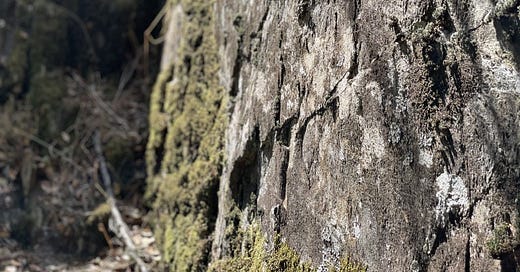Radical principles of animist and shamanic practice in southwestern European territory
Remembrance of the ancient and complex systemic wisdom
The rescue and remembrance of the ancient and complex systemic wisdom of the place we occupy is a life process that must be cared for and attended to with responsibility, integrity, and humbleness.
I leave you some of the stones that guide my path.
1. Sacredness of nature
Animist and shamanic practice (a term used here as a generic basis for understanding awareness and perception of systemic and sacred integration with living places) refers to a deep primal and experiential connection with place, and populations are referred to as native, indigenous, aboriginal, or autochthonous.
2. We speak of places, not countries
In this context, the place or territory is not equivalent to the borders of nations today. The territory is sovereign and governed by its tectonic, geological, topographical, and meteorological laws and its biological, cyclical, and eco-systemic complexity. This includes all the cultural identities that inhabit or have inhabited it.
3. Diversity and hybridization
The rescue and re-creation of this local ancestral wisdom are not about “re-establishing a purity of cultural lineage or homogeneous race,” as this would be a violent reduction of diversity to making ancient cultures limited, “universal” and uniform, ignoring the deep and valuable complexity of the processes of each place.
4. Cultural Absolutism vs. Decolonization of identity
We do not remember or integrate races, pure cultures, or absolute and superior knowledge to others. We navigate the valuable diversity of each ecosystem, decolonizing cultural identity and working in non-binary or linear paradox. In this inquiry of remembering the primal consciousness, we viscerally challenge the anthropocentric perception of reality.
5. Hierarchical and absolutist Romanticism
Noble savage vs primitivism — One must beware of new-age fantasies of indigenous traditions as a romantic idolatrous paradise state, with no tensions, of any tradition. On the other hand, the idea of the “primitive” as inferior, immature, or less evolved than contemporary society is always limited and eurocentric. Being an experiential inquiry and research based on the native/indigenous paradigm, we rephrase why the animist roots in the territory have been abandoned and lost.
6. From the individual to the communal
The notion of modern individualism does not fit into this rescue, for in the individualistic culture, identity is closed off from deep intimacy with the constant spiritual experiences of stories and connections with all aspects of life out there.
7. From Mind to World
The rescue and incorporation of this ancestral wisdom are impossible in an exiled mind that ignores other sources of intelligence, like the body, instinct, intuition, or imagination, and the other than human. And the hierarchized mutilation of the intelligence of other beings and landscapes.
8. Local experience and eco-systemic wisdom
Despite being generated in particular biomes and landscapes, primal knowledge is a flexible system open to cultural exchanges (we have always been nomads), establishing bridges, parallels, and dialogues. It is a mutable experience in permanent transformation and evolution.
9. Everything is alive
Earth is a communion of beings, not objects: all matter and energy are alive and conscious. Sacred life always speaks of cycles of continuous transition.
10. Commitment to diversity
Activism and commitment to including voices in diversity, especially those mutilated, ignored, silenced, neglected, or banned. The shadow of history and culture is essential to face in humility.
11. From judgment to relational
In this kind of wild, shamanic consciousness, there is no good, bad, or ideal. There are needs involved by the contextual richness that generates them. The rituals and practices relating to the sacred must always attend to the specificity of the concrete place and time and not to dogmas or pre-made recipes. It is direct contextual wisdom.
12. The Land remembers — including the whole history
Tapping and recognizing the invisible and “shadow” events taking place, slavery, genocide, and displacement are necessary for healing the land.
13. Somatic embodiment
This primal wisdom resides in a specific body and a specific place. It is its being and nature. Embodiment is not fixed but a process of outside and inside. It is not passive, complete, or constant. It is a rhythmic process that depends on mutual interactions between the brain, body, and place. Furthermore, it speaks to us of a complex systemic relationship of reciprocal response.
14. The Non-Human Others
We have no greater privileges than other animals. Most contemporary indigenous cultures have no words in their lexicon that distinguish people, animals, landscapes, or plants into separate categories. They speak to us of equality and reciprocity rather than hierarchy. According to these views of the cosmos, humans specialize in thinking and stones in being. This way of seeing the world is the foundation of sober but ecstatic humility.
15. The spontaneity of the Sacred
The spontaneity of bodily processes and even of thoughts. To the controlling paradigm of the Western mind, this seems intuitively impossible to achieve, or even negative, because the process is one of control. The depth of the mind, the unconscious, is our wilderness area, and through spontaneity, we can identify ourselves as a collective co-creation in direct relation with the sacred, says Nick Totton.
16. Co-creation
Inherently related to self-balancing, as it speaks of a balanced mind in its environment. It is constantly activated through homeostatic cycles (cyclic mechanisms to rebalance the dynamic system whenever it becomes unbalanced). It is the understanding that consciousness is not locked in the body but a necessary interrelationship between the brain, body, and environment, as Gregory Bateson says.
17. Immanent Wisdom
It is the total of all our experience, all the context, including physiological and genetic resources, by co-creation with the rest of the pluriverse that mirrors and expresses all that the cosmos is.
Reference from 13 to 17: inspired and adapted by Nick Totton’s Wild Mind




